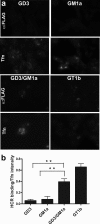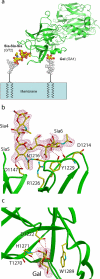Gangliosides as high affinity receptors for tetanus neurotoxin
- PMID: 19602728
- PMCID: PMC2785345
- DOI: 10.1074/jbc.M109.027391
Gangliosides as high affinity receptors for tetanus neurotoxin
Abstract
Tetanus neurotoxin (TeNT) is an exotoxin produced by Clostridium tetani that causes paralytic death to hundreds of thousands of humans annually. TeNT cleaves vesicle-associated membrane protein-2, which inhibits neurotransmitter release in the central nervous system to elicit spastic paralysis, but the molecular basis for TeNT entry into neurons remains unclear. TeNT is a approximately 150-kDa protein that has AB structure-function properties; the A domain is a zinc metalloprotease, and the B domain encodes a translocation domain and C-terminal receptor-binding domain (HCR/T). Earlier studies showed that HCR/T bound gangliosides via two carbohydrate-binding sites, termed the lactose-binding site (the "W" pocket) and the sialic acid-binding site (the "R" pocket). Here we report that TeNT high affinity binding to neurons is mediated solely by gangliosides. Glycan array and solid phase binding analyses identified gangliosides that bound exclusively to either the W pocket or the R pocket of TeNT; GM1a bound to the W pocket, and GD3 bound to the R pocket. Using these gangliosides and mutated forms of HCR/T that lacked one or both carbohydrate-binding pocket, gangliosides binding to both of the W and R pockets were shown to be necessary for high affinity binding to neuronal and non-neuronal cells. The crystal structure of a ternary complex of HCR/T with sugar components of two gangliosides bound to the W and R supported the binding of gangliosides to both carbohydrate pockets. These data show that gangliosides are functional dual receptors for TeNT.
Figures









References
-
- Pappas G., Kiriaze I. J., Falagas M. E. (2008) Int. J. Infect. Dis. 12, 347–350 - PubMed
-
- Schiavo G., Benfenati F., Poulain B., Rossetto O., Polverino de Laureto P., DasGupta B. R., Montecucco C. (1992) Nature 359, 832–835 - PubMed
-
- Bilous J., Eggers R., Gasse F., Jarrett S., Lydon P., Magan A., Okwo-Bele J. M., Salama P., Vandelaer J., Villeneuve P., Wolfson L. (2006) Lancet 367, 1464–1466 - PubMed
-
- Burton R. M., Balfour Y. M. (1962) Biochem. Pharmacol. 11, 974–976 - PubMed
Publication types
MeSH terms
Substances
Associated data
- Actions
- Actions
Grants and funding
LinkOut - more resources
Full Text Sources
Other Literature Sources

